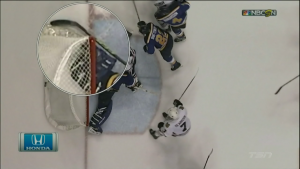The NHL implemented the Coach’s Challenge this season to crack down on close calls. To no one’s surprise, some calls can be missed by the human eye as the game of hockey gets faster and faster. It was framed as a tool for referees and the league to “get it right” when it came to plays like offsides and goals. Both of those circumstances were battled in Game 2 of the Western Conference Semi-Finals between the St. Louis Blues and Chicago Blackhawks on Friday night.
Playing with Fractions
With a 1-1 game over 50 minutes in, the Blues were riding high as Vladimir Tarasenko netted his second of the game. The excitement was dampened just moments later when the Blackhawks’ Head Coach Joel Quenneville decided to challenge the play for an offside.
Entering the zone, Jori Lehtera took a chip pass from Kevin Shattenkirk over the blue line. When the play was reviewed for roughly 10 minutes, it was called back and the shock across the fans’ faces could be felt all over St. Louis.
The NHL Rulebook‘s Rule 83.1 states:
A player is on-side when either of his skates are in contact with, or on his own side of the line, at the instant the puck completely crosses the leading edge of the blue line… the question of an “off-side” never arises until the puck has completely crossed the leading edge of the blue line at which time the decision is to be made.

By this definition, the call is correct. With a closer look, Lehtera’s left foot is slightly lifted over the ice, but is that a
necessary rule? I think that’s the question Blues fans and some NHL fans may want answered this offseason. In the NFL, whether there is a Coach’s Challenge or not, the ball position is determined by the plane the ball is on in relation to the field’s lines. If the ball (or puck and foot) have not crossed the plane of the line, it’s offside. In other words, if the rule was mirrored in the NHL the Tarasenko goal would have counted.
Coaches and the NHL introduced the rule to minimize missed calls. By the rulebook, this one was correct, no matter how heartbreaking it was for Blues fans. Joel Quenneville could be seen after the “no goal” call was made, pointing at his coaching staff, giving them the credit for pointing out the close call and saying “good call, good call.”
Stuffed
Minutes later it was Ken Hitchcock’s turn to use his Coach’s Challenge on a goal by Andrew Shaw. Watching the game, the call for review felt like a desperation move by Hitchcock. Not to say he shouldn’t have gone for it, but that the energy and momentum was sucked from the Scottrade Center so quickly after the previous challenge, maybe this would help turn that around.
On the power play, a rebound shot was stuffed past Brian Elliott by the feisty Andrew Shaw. It was a mad scramble in

front the goaltender, as four players fought for the puck. When the puck had crossed the line and the referee called a goal, Elliott immediately stood up and pleaded for a goaltender interference call. Instead, he got support from his coaching staff in the form of a Coach’s Challenge, arguing that same point.
After a much shorter review this time around, the goal judges and referees determined it was a “good goal.” Shaw stuffed home the goal but did not make significant contact with the goaltender until the puck was already crossing the line. This is a play NHL fans see all the time, especially in the playoffs when in tight goals like this happen more frequently.
The Show Must Go On
Arguments can be made that the challenges took the momentum out of the game. While that may be true, rules are rules and the correct calls were made in these situations.
Ultimately, love it or hate it, the Coach’s Challenge will be here to stay. Agree or disagree with Friday night’s calls, the Blues need to push past the minor set back and play spoiler in Chicago for Games 3 and 4. Any professional athlete will tell you that there are no excuses when they lose a game. St. Louis now looks to Game 3 in the Windy City for another series lead.